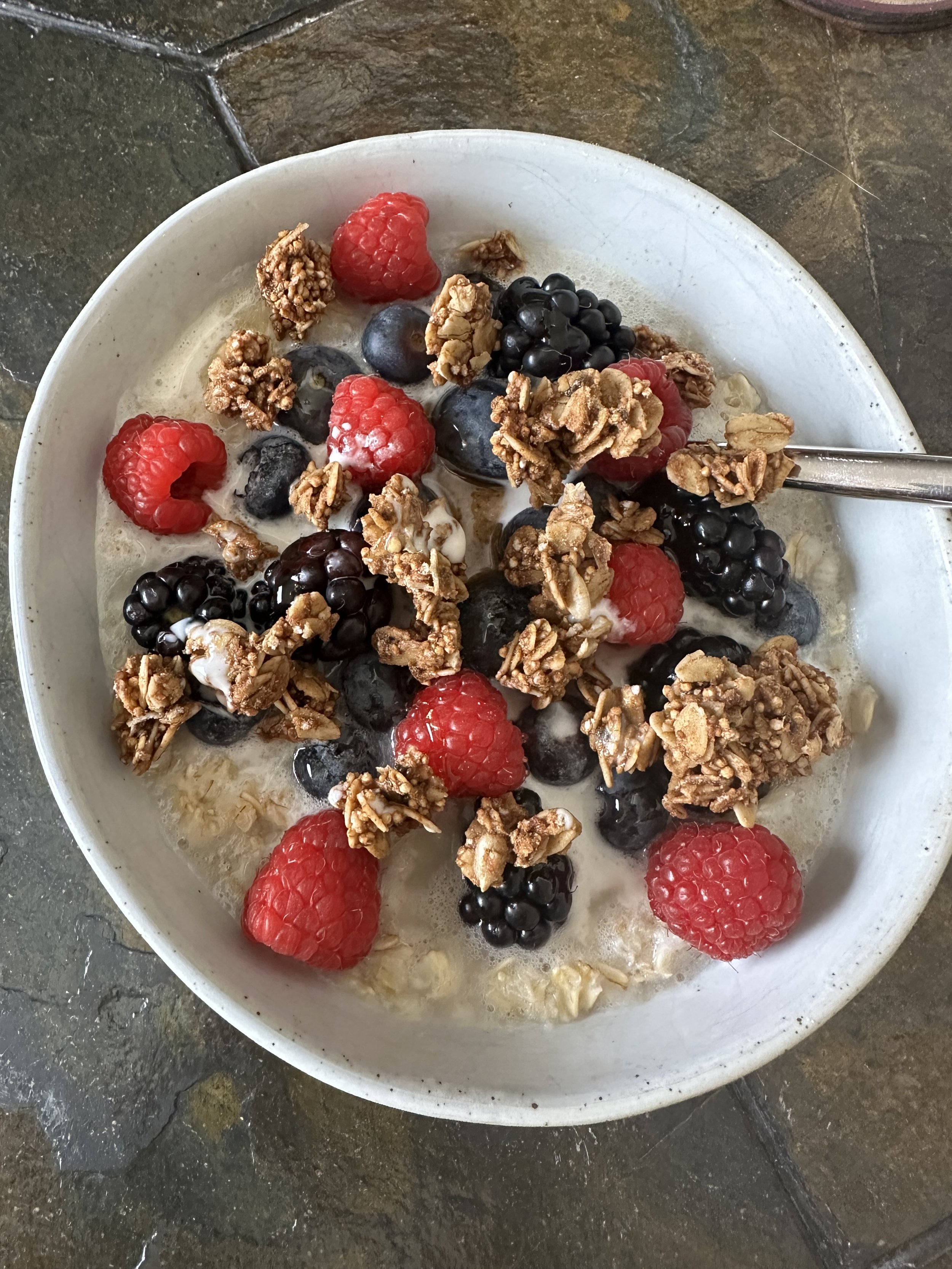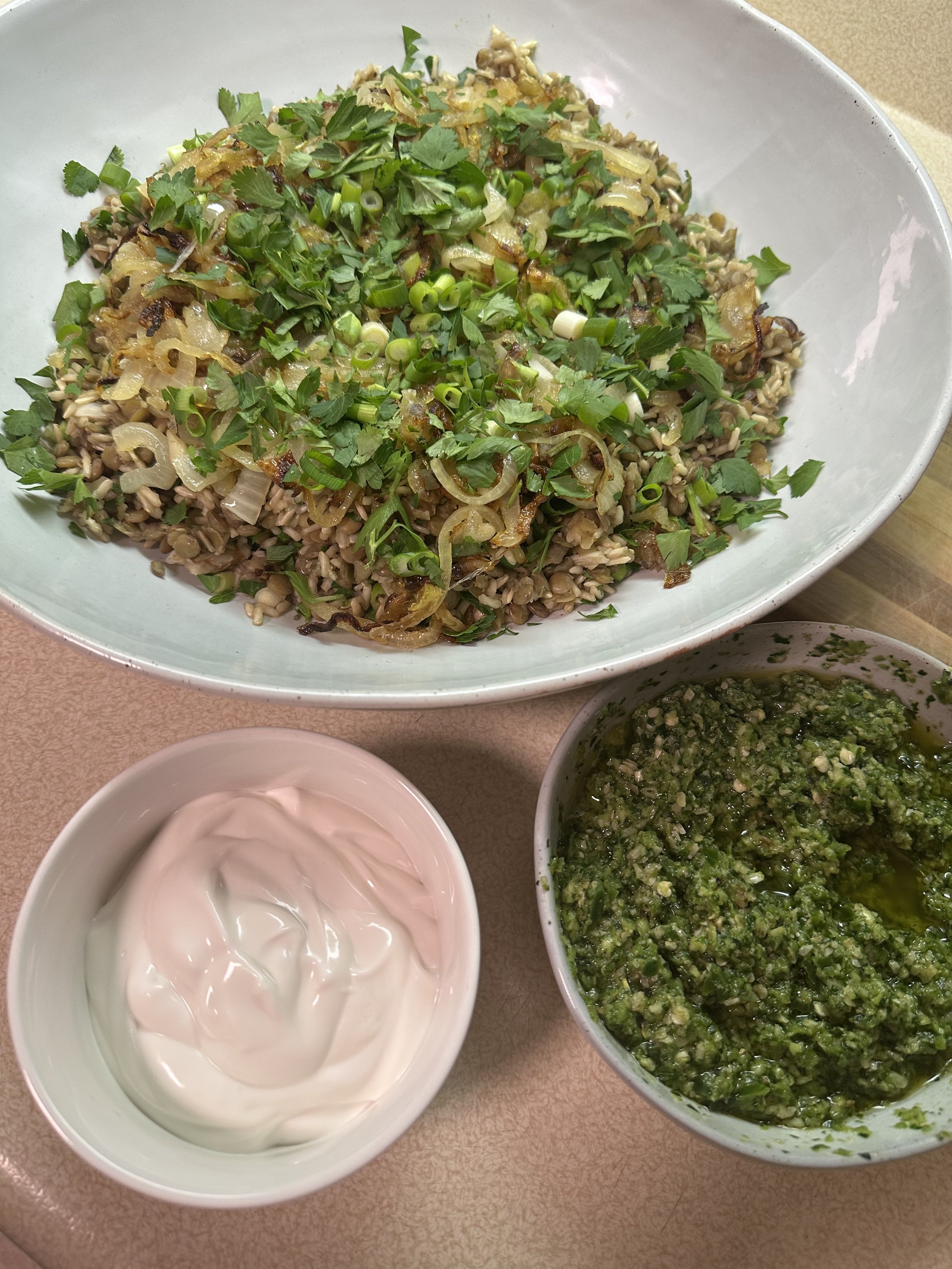What is an Elimination Diet and who should try it?
During my training with the Institute for Functional Medicine, we were all encouraged to complete a 3 week elimination diet. The goal was for us to be able to guide our patients through the process with more ease and success, and to discover a bit about our own gut health along the way. We were able to schedule 5 sessions with a functional health coach to work through the diet as well. Luckily for me, my partner Dan was willing and able to do the diet with me, so we picked a date and started planning.
gluten free oats, almond butter, cashew milk, granola, and fresh berries
What is an Elimination Diet?
An elimination diet is an eating plan that involves removing certain foods and food groups for 3 weeks, then gradually reintroducing one food at a time and monitoring for any symptoms that could indicate a sensitivity to that food. If you do have a sensitivity and symptoms, you then pull the triggering food out of your diet for 3-6 months (allowing the gut to heal and immune system to stop targeting the food) and then reintroduce it again with the goal of being able to tolerate everything eventually. In this case, we followed IFM’s Elimination Diet to a tee, eliminating corn, wheat, dairy, eggs, red meat, soy, added sugars, caffeine, alcohol, and peanuts. These are the foods and food groups most commonly associated with food sensitivity. This required some planning and adapting for us, particularly for breakfast as I like a savory breakfast and eat eggs pretty frequently, but we found that IFM’s guide and a little preparation made this process pretty painless!
mujaddara with almond yogurt and shatta sauce
Who should do an Elimination Diet?
Before we kick off with what you CAN eat, I wanted to be clear about who this diet is designed to help. Anyone with suspected food sensitivity/allergy without the kind of food allergy that causes anaphylaxis/hives/oral swelling and those with bloating and abdominal pain, acne, autoimmune disease, IBS, eosinophilic esophagitis, and more can try this diet to see if food is contributing to/perpetuating an inflammatory state in the body. This diet is restrictive to the above-mentioned food groups, so if you have a history of disordered eating, it is not recommended. I am happy to work with you to discover any food sensitivities in a safe and sustainable way that works for you. It can also make you more aware of your body and how it reacts to food, so if you are already hyper-aware of your body and need to maybe focus a little less on it, this is not the right fit for you. If you are nursing or pregnant, while this is not a calorie-restricted diet, it can be an extra challenge to get adequate calories and nutrients, so you may want to hold off until you are no longer in a state of increased metabolic demand or work carefully and closely with a trusted health professional during this process.
Author’s Note:
I believe firmly in food freedom and not thinking of any food as “good” or “bad.” Over the past year, I have been suspecting that I had a gluten and dairy sensitivity, and I was curious to learn a bit more about my body and how to counsel patients through this diet. I was also in a safe space to do this, in a stable relationship with my body and food when we started, and I had the support of my partner and my temporary health coach, Jenny. I knew that if I got into a headspace that did not feel healthy, I would be able to talk to one of them and would stop the diet. I would encourage anyone trying it to have at least the same foundational support system and headspace, and to remember that the very tail end goal of an elimination diet is to be able to eat everything you want in moderation without symptoms. I believe that this temporary diet ultimately is in alignment with intuitive eating and food freedom, but it is not for everyone and timing really matters.
kale greek salad with vegan feta and lemon vinaigrette
What CAN I eat on an elimination diet?
I found it more helpful to focus on what I could eat, rather than what I could not. Nuts and legumes (excluding peanuts), poultry, fish, lamb, bison (100% grass fed), vegetables, fruits, and whole grains are all allowed on the diet. Oats were permitted, as long as they were certified gluten free, because many store-bought oats can contain gluten due to farming and processing practices. Small amounts of honey or maple syrup as a sweetener (less than 3tsp daily) are permitted. Some folks permitted green tea for the antioxidant effect, but we left it out as we are caffeine lovers who needed a break! I really enjoyed finding recipes that fit the diet and changing favorite recipes around to accommodate our temporary restrictions. I will post more detail and links to recipes, but a typical day for me was overnight steel cut oats with berries and almond butter for breakfast, a salad (IFM has an amazing chicken quinoa salad that we made almost every week) for lunch, and either a modified soup or a grain, veggie, and protein for dinner. I made homemade granola that we would have as a snack or dessert (Dan liked it with almond yogurt), and we also snacked on nuts, veggies, hummus, and rotisserie chicken when we needed it. I kept reminding myself and Dan that this is not a calorie restricted diet, so we felt quite a bit of freedom around food and eating despite the temporary restrictiveness of the diet.
I want to try an Elimination Diet. How do I get started?
I recommend working with an Integrative or Functional Medicine doctor to see if this is the right thing for you to try. If so, they may pair you with a functional health coach as well to ensure that you can be successful with the diet, identify any possible road blocks, and have regular follow ups to pivot and adjust the plan as needed. Also check out my next post for a few easy recipes to kick things off, as well as what I ate in a week on the diet!


